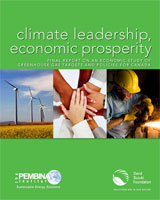|
 The David Suzuki Foundation and the Pembina Valley Institute released their controversial and powerful report, Climate Leadership, Economic Prosperity: Final Report on an Economic Study of Greenhouse Gas Targets and Policies for Canada in preparation for the UN Climate Summit in Copenhagen in December, 2009. Commissioned by TD Bank of Canada and carried out by the economic modelling firm M.K. Jaccard and Associates, this report was commissioned to look at two basic scenarios regarding Green House Gas (GHG) emissions. The David Suzuki Foundation and the Pembina Valley Institute released their controversial and powerful report, Climate Leadership, Economic Prosperity: Final Report on an Economic Study of Greenhouse Gas Targets and Policies for Canada in preparation for the UN Climate Summit in Copenhagen in December, 2009. Commissioned by TD Bank of Canada and carried out by the economic modelling firm M.K. Jaccard and Associates, this report was commissioned to look at two basic scenarios regarding Green House Gas (GHG) emissions.
Click here to read more
 In Canada, most provinces and territories have announced a carbon policy or are in the process of doing so. Discussion is occurring about the best way to price on carbon to achieve greenhouse gas emissions reductions.
In Canada, most provinces and territories have announced a carbon policy or are in the process of doing so. Discussion is occurring about the best way to price on carbon to achieve greenhouse gas emissions reductions.
Carbon taxes and cap and trade systems are the two main mechanisms that can be used to put a price on greenhouse gas pollution. A carbon tax is levied by governments on emissions of greenhouse gases. The tax is often built on a sliding, gradual increase in the price of carbon. In a cap-and-trade system, government sets the ceiling (the "cap") on total emissions from a group of polluters through formal means (legislation or regulation), but allows them to trade emission "allowances" within the cap.
The David Suzuki Foundation and the Pembina Institute have released materials to inform the discussion and offer a series of questions that should be posed in evaluating carbon pricing policy.
 Download May 29, 2008 David Suzuki Foundation (DSF) Briefing Note: Why a Carbon Tax and/or Cap-and-Trade System is needed to reduce global warming emissions (PDF) Download May 29, 2008 David Suzuki Foundation (DSF) Briefing Note: Why a Carbon Tax and/or Cap-and-Trade System is needed to reduce global warming emissions (PDF)
 Download May 29, 2008 Pembina Institute/DSF Fact Sheet: Carbon Taxes: Key Issues, Key Questions (PDF) Download May 29, 2008 Pembina Institute/DSF Fact Sheet: Carbon Taxes: Key Issues, Key Questions (PDF)
 Download 2008 Liberal party of Canada Green Shift Plan (PDF) Download 2008 Liberal party of Canada Green Shift Plan (PDF)
Sources: David Suzuki Foundation, Pembina Institute
Individual Actions to Reduce GHGs
 Download David Suzuki Foundation: 10 Ways you can stop global warming, reduce energy consumption and make a difference (PDF) Download David Suzuki Foundation: 10 Ways you can stop global warming, reduce energy consumption and make a difference (PDF)
The Global Commons Institute (GCI) is an independent organization concerned with its mission to "globally shrink and share future greenhouse gas emissions to avert dangerous rates of global climate change". GCI has proposed a system known as 'contraction and convergence' (C&C) that addresses principles that need to be the foundation of international agreements on climate change and greenhouse gas (GHG) reduction - the precautionary principle, the principle of sustainable development , the 'polluter pays' principle and the principle of equity.
The Global Commons Institute (GCI) first proposed the "Contraction and Convergence" (C&C) science-based, global climate-policy framework to the United Nations and the world in 1990.
Visit the Global Commons Institute web site
Contraction & Convergence: The Definitions
- Contraction refers to the global reduction of GHG emissions required to stabilize atmospheric GHG concentrations at a level that science regards as a probably tolerable atmospheric concentration.
- Convergence refers to the equalization of per-capita shares of GHG.
- Precautionary principle - the decision to err on the side of caution in the face of uncertainty or incomplete science
- Sustainable development - development which meets today's needs without compromising the ability of future generations to meet their own needs
- Polluter pays principle - the country, organization or person that causes pollution should pay to rectify the damage that it causes
- Principle of equity - both intergenerational and international; each person in the world has the same right to use an equal amount of global environmental space or the earth's resources (or to reduce such use)
Under the C&C system, emissions are allocated to nations on an equal per capita basis, while allowing emissions trading to occur (e.g. a country whose emissions are below its quota can 'sell' the balance to a country whose emissions exceed its quota).
Contraction & Convergence: The Concept
Under a C&C system to address climate change, the following steps would occur:
- all countries would collectively agree a target for a stable atmospheric concentration of carbon dioxide in the atmosphere.
- calculate a 'global emissions budget' or 'contraction budget' derived from the target atmospheric concentration figure (this atmospheric concentration target would be subject to annual review so that it could be revised according to new scientific findings)
- create a simple and logical allocation formula for convergence of emissions allocations over time such that at a specified date, country allowances/entitlements become proportional to national population as at a specified baseline year (the current situation whereby allocations are generally proportional to wealth would cease to exist)
- after convergence, all countries would contract their greenhouse gas emissions equally until the necessary contraction limit is reached
- international emissions trading would be possible so that countries with low per capita emissions could sell their spare permits to countries unable to manage within their shares, giving developing countries an incentive to invest the proceeds in clean technology since this would give them more permits to sell.
Seven-Point Strategy for Climate Change
- Implement a climate plan that effectively reduces all major Canadian sources of GHGs, unequivocally re-commits to meeting all Canada's obligations under the Kyoto Protocol and sets science-based targets for the longer term; and move immediately to:
- Prepare regulations that set absolute emission targets for the biggest industrial polluters and apply no later than 2008. Energy efficiency regulations for appliance and equipment manufacturers and others must be aggressively strengthened in the same timeframe.
- For the automotive sector, regulate GHG emissions in a manner at least as stringent as California's regulation.
- Announce aggressive national objectives and adequate supporting funds for the deployment of low-impact renewable energy in the electricity, heating and transportation sectors.
- Restore and expand the EnerGuide for Houses grants program.
- Increase investment in research on climate impacts and adaptation in line with the recommendations of the Canadian Foundation for Climate and Atmospheric Sciences.
- Invest in effective programs to educate Canadians about climate change and engage them in solutions.
View detailed Seven-point strategy at Nature Canada
Visit the Climate Action Network Web site
Source: Climate Action Network, Nature Canada |
According to the World Resources Institute (WRI), 2005 was a year when scientific discoveries and new climate change research shows that the physical consequences of climate change are no longer theoretical - they are very real and they can be quantified.
Taken collectively, some of the major 2005 discoveries suggest the world may well have moved past a key physical tipping point. Several key in the climate science dialogue are supported by 2005 findings:
- the effects of climate change are occurring at a scale that adds enormous urgency to efforts to prevent additional change and also to efforts to adapt to climate impacts already occurring;
- climate impacts will continue even if emissions of greenhouse gases are halted immediately.
 Researchers at the WRI reviewed a wide body of scientific and technical literature and prepared the WRI Issue Brief, Climate science 2005: Major new discoveries. Within the Issue Brief, each scientific paper reviewed is briefly described and a summary of the implications of each discovery is provided. The full citation for the original paper is also included.
Researchers at the WRI reviewed a wide body of scientific and technical literature and prepared the WRI Issue Brief, Climate science 2005: Major new discoveries. Within the Issue Brief, each scientific paper reviewed is briefly described and a summary of the implications of each discovery is provided. The full citation for the original paper is also included.
 Download the Climate science 2005: Major new discoveries brief (PDF) Download the Climate science 2005: Major new discoveries brief (PDF)
The Issue Brief is divided into four sections, each of which can be accessed separately as html pages:
View the Physical Climate section
View the Hydrological Cycle section
View the Ecosystems section
View the Technologies for Climate Change Mitigation section
Climate Action Network Proposal for Discussion: A Viable Global Framework for Preventing Dangerous Climate Change
 CAN International has prepared a proposal for a global framework to prevent dangerous climate change. The proposal is for discussion purposes and is not intended to represent the views of all of CAN's member organizations.
CAN International has prepared a proposal for a global framework to prevent dangerous climate change. The proposal is for discussion purposes and is not intended to represent the views of all of CAN's member organizations.
CAN's proposed global framework incorporates the concept of Contraction and Convergence (see above), but builds on this by including mechanisms to account for historical responsibility, ability to pay and includes some practical suggestions in terms of the C&C ideas regarding per capita convergence, recognizing the need to eventually include some countries that are major emitters of GHG that are not currently bound by the Kyoto Protocol.
View CAN publication A Viable Global Framework for Preventing Dangerous Climate Change (PPT)
The Climate Action Network (CAN International) is a worldwide network of over 340 Non- Governmental Organizations (NGOs) working to promote government and individual action to limit human-induced climate change to ecologically sustainable levels.
Visit the Climate Action Network (CAN) web site
Climate Action Network Canada (CAN Canada) is the Canadian Office of CAN. CAN Canada member organizations are committed to preventing dangerous levels of human interference with the global climate system, protecting environmental sustainability and public health, while upholding principles of just transition, equity and social justice.
Visit the Climate Action Network Canada (CAN Canada) web site
CAN's Proposed Framework - Principles
CAN's proposed global framework for preventing dangerous climate change is based on three core principles that should form the basis for the allocation of actions to limit and reduce global emissions:
Equity, responsibility and ability or capacity to act.
The equity principle requires, amongst other things, that all have equal access to the atmospheric commons. One of its implications is those that have already contributed to the climate change problem substantially need to create the space for others to emit more in the future. In addition the setting of the relative emission targets for countries should be designed to give increasing weight to the aim of per capita emissions convergence over the course of the 21st century. Intergenerational equity is also important and means that the present generation should not pass to future generations unfair burdens. Delaying action on climate change now would transfer large costs to future generations.
The principle of historical responsibility is an important element in determining who should act and when.
The ability to pay and the capacity to act are important principles in deciding who should act, when and in what way.
Further principles enunciated in the CAN position on adequacy of commitments, entitled Preventing Dangerous Climate Change that need to be applied in designing and running the international regime for the prevention of dangerous climate change are:
- The precautionary principle, found, inter alia, in Article 3.3 of the UNFCCC.
- The general principle of international law that activities within the jurisdiction of one country must not lead to grave damage on another state's territory.
- The right to sustainable development, in particular equitable access to affordable energy services, livelihoods, food security, health, water and other basic human needs.
- The basic right to life and physical integrity, as they are embodied in a number of international treaties and the Universal Declaration of Human Rights.
- The obligations on Parties to treaties must be performed in good faith.
CAN Three Track Framework
CAN believes that climate action must be driven by the aim of keeping global warming as far below 2°C as possible in order to prevent dangerous interference with the climate system. The other core belief is that a viable international system for achieving this objective must reflect the moral responsibility of those who have benefited the most from the use of the global commons to reduce their emissions first and to compensate the victims of climate change.
 A system of three parallel, inter-linked tracks operating on the same or a very similar timetable:
A system of three parallel, inter-linked tracks operating on the same or a very similar timetable:
The Kyoto Track
The Greening (Decarbonisation) Track
The Adaptation Track
The Kyoto Track
- builds upon the UNFCCC and the Kyoto Protocol
- legally binding
- absolute emission reductions and compliance regime
- tradable emissions credits
- deep emissions cuts by industrialised countries through absolute mandatory caps
- include small set of developing countries according to a set of criteria
The 'Greening' (Decarbonisation) Track
- actions and policies would drive the rapid introduction of clean technologies that can reduce emissions and meet sustainable development objectives in developing countries
- enable developing countries to follow a low carbon path to development
- resources and technology provided by industrialized countries
- include the majority of developing countries
The Adaptation Track
- provides the resources to the most vulnerable regions (small island states, least developed countries) to deal with unavoidable climate changes
- resources provided by industrialized countries
- countries receiving support under the Adaptation track could also operate in the Greening (decarbonisation) track
The level and the character of the mitigation actions within [the proposed CAN] framework would be determined by reference to agreed level of per capita emissions, ability or capacity to act (including measures such as per capita income) and historical responsibility. Industrialized countries would have the obligation to act first to reduce their emissions in absolute terms. The emission reduction targets in the emission reduction stage of the Kyoto track would be set with a strong reference to the need for per capita emissions to converge over the course of the 21st century. Other fairness criteria such as historical responsibility would also play a role in setting the overall timing, level and character of the emission action required of different countries. A combination of factors such as per capita emissions, ability or capacity to act and historical responsibility could be used to determine when and how countries move from the 'Greening' or decarbonisation track to the Kyoto track.
|

 Researchers at the WRI reviewed a wide body of scientific and technical literature and prepared the WRI Issue Brief, Climate science 2005: Major new discoveries. Within the Issue Brief, each scientific paper reviewed is briefly described and a summary of the implications of each discovery is provided. The full citation for the original paper is also included.
Researchers at the WRI reviewed a wide body of scientific and technical literature and prepared the WRI Issue Brief, Climate science 2005: Major new discoveries. Within the Issue Brief, each scientific paper reviewed is briefly described and a summary of the implications of each discovery is provided. The full citation for the original paper is also included. Download the Climate science 2005: Major new discoveries brief (PDF)
Download the Climate science 2005: Major new discoveries brief (PDF) CAN International has prepared a proposal for a global framework to prevent dangerous climate change. The proposal is for discussion purposes and is not intended to represent the views of all of CAN's member organizations.
CAN International has prepared a proposal for a global framework to prevent dangerous climate change. The proposal is for discussion purposes and is not intended to represent the views of all of CAN's member organizations. A system of three parallel, inter-linked tracks operating on the same or a very similar timetable:
A system of three parallel, inter-linked tracks operating on the same or a very similar timetable:  2002-2014
2002-2014


 The David Suzuki Foundation and the Pembina Valley Institute released their controversial and powerful report, Climate Leadership, Economic Prosperity: Final Report on an Economic Study of Greenhouse Gas Targets and Policies for Canada in preparation for the UN Climate Summit in Copenhagen in December, 2009. Commissioned by TD Bank of Canada and carried out by the economic modelling firm M.K. Jaccard and Associates, this report was commissioned to look at two basic scenarios regarding Green House Gas (GHG) emissions.
The David Suzuki Foundation and the Pembina Valley Institute released their controversial and powerful report, Climate Leadership, Economic Prosperity: Final Report on an Economic Study of Greenhouse Gas Targets and Policies for Canada in preparation for the UN Climate Summit in Copenhagen in December, 2009. Commissioned by TD Bank of Canada and carried out by the economic modelling firm M.K. Jaccard and Associates, this report was commissioned to look at two basic scenarios regarding Green House Gas (GHG) emissions.
 In Canada, most provinces and territories have announced a carbon policy or are in the process of doing so. Discussion is occurring about the best way to price on carbon to achieve greenhouse gas emissions reductions.
In Canada, most provinces and territories have announced a carbon policy or are in the process of doing so. Discussion is occurring about the best way to price on carbon to achieve greenhouse gas emissions reductions.